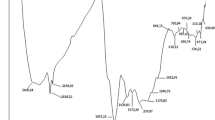Abstract
Oxidation of flotation concentrate of a pyrrhotite-rich sulfide ore by acidophilic chemolithoautotrophic microbial communities at 35, 40, and 45°C was investigated. According to the physicochemical parameters of the liquid phase of the pulp, as well as the results of analysis of the solid residue after biooxidation and cyanidation, the community developed at 40°C exhibited the highest rate of oxidation. The degree of gold recovery at 35, 40, and 45°C was 89.34, 94.59, and 83.25%, respectively. At 40°C, the highest number of microbial cells (6.01 × 109 cells/mL) was observed. While temperature had very little effect on the species composition of microbial communities (except for the absence of Leptospirillum ferriphilum at 35°C), the shares of individual species in the communities varied with temperature. Relatively high numbers of Sulfobacillus thermosulfidooxidans, the organism oxidizing iron and elemental sulfur at higher rates than other acidophilic chemolithotrophic species, were observed at 40°C.
Similar content being viewed by others
References
Kondrat’eva, T.F., Biogeotechnology for recovery of noble and nonferrous metals: present state and prospects, Vestn. Biotekhnol., 2009, vol. 5, no. 1, pp. 49–62.
Kondrat’eva, T.F., Pivovarova, T.A., Tsaplina, I.A., Fomchenko, N.V., Zhuravleva, A.E., Murav’ev, M.I., Melamud, V.S., and Bulayev, A.G., Diversity of the communities of acidophilic chemolithotrophic micro-organisms in natural and technogenic ecosystems, Microbiology (Moscow), 2012, vol. 81, no. 1, pp. 1–24.
Bulaev, A.G., Pivovarova, T.A., Melamud, V.S., Tsaplina, I.A., Zhuravleva, A.E., and Kondrat’eva, T.F., Polymorphism of Sulfobacillus thermosulfidooxidans dominating in processes of high-temperature oxidation of gold-arsenic concentrate, Microbiology (Moscow), 2011, vol. 80, no. 3, pp. 326–334.
Bulaev, A.G., Pivovarova, T.A., Melamud, V.S., Bumazhkin, B.K., Patutina, E.O., Kolganova, T.V., Kuznetsov, B.B., and Kondrat’eva, T.F., Changes in the species composition of a thermotolerant community of acidophilic chemolithotrophic microorganisms upon switching to the oxidation of a new energy substrate, Microbiology (Moscow), 2012, vol. 81, no. 4, pp. 391–396.
Murav’ev, M.I., Pivovarova, T.A., Tourova, T.P., Bulayev, A.G., Fomchenko, N.V., and Kondrat’eva, T.F., Identification of the dominant bacterium of two-stage biooxidation of gold-arsenic concentrate, Microbiology (Moscow), 2010, vol. 79, no. 3, pp. 342–348.
Kondrat’eva, T.F., Pivovarova, T.A., Bulaev, A.G., Moshchanetskii, P.V., Tsaplina, I.A., Grigor’eva, N.V., Zhuravleva, A.E., Melamud, V.S., and Belyi, A.V., Selection of a community of acidochemolithotrophic microorganisms with a high oxidation rate of pyrrhotite-containing sulphide ore flotation concentrate, Appl. Biochem. Microbiol., 2013, vol. 49, no. 5, pp. 495–501.
Reznikov, A.A., Mulikovskaya, E.P., and Sokolov, I.Yu., Metody analiza prirodnykh vod (Methods for Analysis of Natural Waters), Moscow: Nedra, 1970.
Suvorovskaya, I.A., Titov, V.I., Brodskaya, V.M., Vasil’ev, P.I., Lipshchits, B.M., and Elentur, M.P., Arsecin determination, in Tekhnicheskii analiz tsvetnoi metallurgii (Technical Analysis for Nonferrous Metallurgy), Moscow: Metallurgiya, 1957.
Filippova, N.A., Fazovyi analiz rud i produktov ikh pererabotki (Phase Analysis of Ores and Procession Products), Moscow: Khimiya, 1975.
Karavaiko, G.I., Methods for isolation, enumeration, and identification of microorganisms, in Biogeotekhnologiya metallov. Prakticheskoe rukovodstvo (Biogeotechnology of Metals. A Practical Guide), Karavaiko, G.I., Rossi, J., Agate, A., Grudev, S., and Avakyan, Z.A, Eds., Moscow: Tsentr Mezhdunarodnykh Proektov GKNT, 1989, pp. 64–71.
Boulygina, E.S., Kuznetsov, B.B., Marusina, A.I., Kolganova, T.V., Tourova, T.P., Kravchenko, I.K., Bykova, S.A., and Galchenko, V.F., A study of nucleotide sequences of nifH genes of some methanotrophic bacteria, Microbiology (Moscow), 2002, vol. 71, no. 4, pp. 425–432.
Lane, D. J. 16S/23S sequencing, in Nucleic Acid Techniques in Bacterial Systematics, Stackebrandt, E. and Goodfellow, M., Eds., Chichester: Wiley, 1991, pp. 115–175.
Kolganova, T.V., Kuznetsov, B.B., and Tourova, T.P., Designing and testing oligonucleotide primers for amplification and sequencing of archaeal 16S rRNA genes, Microbiology (Moscow), 2002, vol. 71, no. 2, pp. 243–246.
Sanger, F., Nicklen, S., and Coulson, A.R., DNA sequencing with chain-terminating inhibitors, Proc. Natl. Acad. Sci. U. S. A., 1977, vol. 84, pp. 5463–5467.
Thompson, J.D., Higgins, D.G., and Gibson, T.J., CLUSTAL W: improving the sensitivity of progressive multiple sequence alignment through sequence weighting, positions-specific gap penalties and weight matrix choice, Nucleic Acids Res., 1994, vol. 22, no. 22, pp. 4673–4680.
van Hille, R.P., van Wyk, N., and Harrison, S.T.L., Review of microbial ecoclogy of BIOX reactors illustrates the dominance of the genus Ferroplasma in many commercial reactors, in Proceed. 19th Int. Biohydrometallurgy Symp. (IBS 2011), Guanzhou, Q., Tao, J., Wending, Q., Xueduan, L., Yu, Y., and Haidong, W., Eds., Changsha: Central South Univ. Press, 2011, p. 1021.
Okibe, N., Gericke, M., Hallberg, K.B., and Johnson, D.B., Enumeration and characterization of acidophilic microorganisms isolated from a pilot plant stirred-tank bioleaching operation, Appl. Environ. Microbiol., 2003, vol. 69, pp. 1936–1943.
Melamud, V.S. and Pivovarova, T.A,. Specific features of the growth of the type strain of Sulfobacillus thermosulfidooxidans in medium 9K, Appl. Biochem. Microbiol., 1998, vol. 34, no. 3, pp. 281–286.
Author information
Authors and Affiliations
Corresponding author
Additional information
Original Russian Text © P.V. Moshchanetskiy, T.A. Pivovarova, A.V. Belyi, T.F. Kondrat’eva, 2014, published in Mikrobiologiya, 2014, Vol. 83, No. 3, pp. 328–335.
Rights and permissions
About this article
Cite this article
Moshchanetskiy, P.V., Pivovarova, T.A., Belyi, A.V. et al. Effect of temperature on the rate of oxidation of pyrrhotite-rich sulfide ore flotation concentrate and the structure of the acidophilic chemolithotrophic microbial community. Microbiology 83, 255–261 (2014). https://doi.org/10.1134/S0026261714030138
Received:
Published:
Issue Date:
DOI: https://doi.org/10.1134/S0026261714030138



